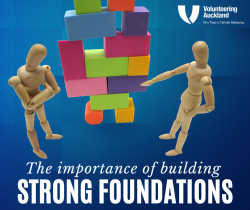Building strong foundations: Why volunteering infrastructure must be properly resourced

Volunteers play a crucial role in the mission delivery of many charities, community groups, and not-for-profits across Aotearoa New Zealand and beyond. Their time, energy, skills, and commitment extend the reach and impact of countless programmes — from emergency responses and mentoring to food distribution, conservation, and cultural events. Yet despite this, the infrastructure required to engage, support, and retain volunteers is too often overlooked, underfunded, and undervalued.
At the heart of this infrastructure are the Leaders of Volunteers — the dedicated staff who recruit, train, coordinate, and care for the volunteers that fuel an organisation’s mission. These roles are essential. Yet in many organisations, they are often siloed, under-resourced, and excluded from executive-level planning. This marginalisation not only places unfair pressure on these leaders but also undermines the effectiveness and sustainability of volunteer programmes as a whole.
The Hidden Backbone of Community Impact
Effective volunteering doesn’t just happen. Behind every successful volunteer programme is a foundation of thoughtful planning, robust systems, clear processes, and strong relationship management. This includes role development, recruitment, orientation, training, supervision, safety procedures, ongoing communication, recognition, and evaluation.
All of this takes time and expertise — and it requires investment. Unfortunately, volunteer engagement is often perceived as low-cost or even free. As a result, the volunteer programme is typically the first to face budget cuts during times of financial constraint, especially when funders or leadership teams prioritise front-line service delivery.
But this view is short-sighted. Cutting volunteer programme budgets erodes the very capacity organisations need to deliver those same services. Volunteers are not 'free labour' — they are unpaid team members whose value can only be realised if the right infrastructure is in place to support them.
Leaders of Volunteers: Isolated but Essential
The individuals who lead volunteer engagement are often passionate, skilled, and deeply committed to their organisations. But they are frequently the only person in the organisation dedicated to volunteer coordination. They may sit outside senior leadership structures, with limited influence on strategy or programme design. Their work can be seen as administrative rather than strategic — when in fact, volunteer engagement is a key component of organisational capacity, culture, and community connection.
This isolation has real consequences. When Leaders of Volunteers are not included in leadership discussions, opportunities for innovation, collaboration, and long-term planning are lost. Volunteer programmes become reactive rather than proactive, filling gaps in staffing rather than being built into service models. Leaders of Volunteers may also experience professional burnout due to high expectations, limited support, and a lack of recognition for the complexity of their role.
The Risk of Under-Resourcing
When volunteer programmes are under-resourced, organisations face several challenges:
- Poor volunteer retention: Without adequate onboarding, training, and communication, volunteers are less likely to feel connected or confident. This leads to high turnover and lost institutional knowledge.
- Limited impact: Volunteers are unable to contribute meaningfully if their roles are unclear, underdeveloped, or poorly supported. This limits the difference they can make — for clients, communities, and the organisation.
- Increased risk: Insufficient infrastructure can create health and safety risks, breaches of confidentiality, or inconsistent service quality.
- Low morale: Volunteers and the people who lead them may feel undervalued, invisible, or disconnected from the organisation’s purpose.
All of these factors compromise an organisation’s ability to deliver on its mission. Conversely, when volunteering is well-supported, it expands reach, builds stronger relationships with community, enhances resilience, and opens up new avenues for programme delivery.
Capacity Building Through Volunteer Engagement
Far from being a cost, a well-run volunteer programme is an investment in organisational capacity. Volunteers bring a wide range of skills, experiences, and perspectives. When matched well and supported properly, they can:
- Test and lead new initiatives
- Strengthen relationships with the communities served
- Support cultural and linguistic inclusion
- Provide surge capacity during busy periods or crises
- Offer professional expertise in areas such as marketing, IT, finance, and governance
To realise these benefits, volunteer engagement must be built into strategic planning, properly resourced, and aligned with the organisation’s goals. This includes having a clear volunteer engagement strategy, budget lines for volunteer programme activities, professional development for Leaders of Volunteers, and systems for measuring the impact of volunteering on both outcomes and organisational health.
A Strategic Priority, Not a Side Project
Organisations that take volunteer engagement seriously see volunteers not as 'helpers' but as co-creators of change. These organisations ensure Leaders of Volunteers are part of senior leadership teams. They track volunteer impact alongside other programme indicators. They embed volunteer voice in programme design and feedback loops. Most importantly, they invest in the systems and staffing needed to make this all possible.
Key elements of strong volunteering infrastructure include:
- A dedicated volunteer manager or team
- Volunteer management software and tools
- Role development and skills matching processes
- Accessible, inclusive onboarding and training
- Ongoing communication and supervision
- Recognition and celebration strategies
- Evaluation and reporting on volunteer contribution
These aren’t 'nice to haves' — they’re essential components of successful, ethical, and sustainable volunteering.
The Cost of Neglect — and the Power of Support
Neglecting volunteer infrastructure weakens organisations from the inside out. It contributes to staff stress, inconsistent service delivery, community disengagement, and missed opportunities. On the other hand, investing in this infrastructure helps organisations grow, innovate, and navigate uncertainty with a broader base of people and skills.
Volunteers offer their time freely, but it is our responsibility to ensure that time is well used, well supported, and genuinely impactful. That begins with resourcing the people and systems that make volunteering possible.
Volunteering is a powerful force for community good — but only when the foundations are strong. Let’s stop treating volunteering as an afterthought and start building the infrastructure it truly needs and deserves.

